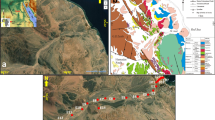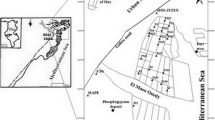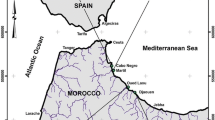Abstract
Trace metal contents (Cd, Co, Cr, Cu, Hg, Mn, Ni, Pb and Zn) have been measured in 27 surface sediment samples collected from Kongsfjorden, Svalbard, Norwegian Arctic. The analyses yielded concentration values (in mg kg−1) of 0.13–0.63 for Cd, 11.89–21.90 for Co, 48.65–81.84 for Cr, 21.26–36.60 for Cu, 299.59–683.48 for Mn, 22.43–35.39 for Ni, 10.68–36.59 for Pb, 50.28–199.07 for Zn and 8.09–65.34 for Hg (in ng g−1), respectively. Relative cumulative frequency method has been used to define the baseline values of these metals, which (in mg kg−1) were 0.14 for Cd, 13.56 for Co, 57.86 for Cr, 25.14 for Cu, 364.08 for Mn, 26.22 for Ni, 17.46 for Pb, 70.49 for Zn and 9.76 for Hg (in ng g−1), respectively. The enrichment factor analysis indicated that Hg showed some extent of anthropogenic pollution, while Pb, Zn and Cd showed limited anthropogenic contamination in the study areas.






Similar content being viewed by others

References
Aagaard, K., Foldvik, A., & Hillman, S. R. (1987). The West Spitsbergen Current: Disposition and water mass transformation. Journal of Geophysical Research, 92, 3778–3784.
Altug, G., & Balkis, N. (2009). Levels of some toxic elements and frequency of bacterial heavy metal resistance in sediment and sea water. Environmental Monitoring and Assessment, 149, 61–69.
AMAP. (1998). AMAP Assessment Report: Arctic pollution issues. Oslo: Arctic Monitoring and Assessment Programme.
AMAP Assessment 2002. (2005). Heavy metals in the Arctic. Published by Arctic Monitoring and Assessment Programme, Oslo.
Arujo, M., Fatima, D., Bernard, P. C., & Van Grieben, R. E. (1988). Heavy metal contamination in sediments from the Belgian coast and Scheldt estuary. Marine Pollution Bulletin, 19, 269–273.
Avila-Pérez, P., Garcia-Aragón, J. A., Diaz-Delgado, C., Tejeda-Vega, S., & Reyes-Gutiérrez, R. (2002). Heavy metal distribution in bottom sediments of a Mexican reservoir. Aquatic Ecosystem Health & Management, 5, 205–216.
Bai, J. H., Cui, B. S., Chen, B., Zhang, K. J., Deng, W., Gao, H. F., et al. (2011). Spatial distribution and ecological risk assessment of heavy metals in surface sediments from a typical plateau lake wetland, China. Ecological Model, 222, 301–306.
Baptista Neto, J. A., Gingele, F. X., Leipe, T., & Brehme, I. (2006). Spatial distribution of heavy metals in surficial sediments from Guanabara Bay: Rio de Janeiro, Brazil. Environmental Geology, 49, 1051–1063.
Bauer, I., & Bor, J. (1995). Lithogene, geogene and anthropogene Schwermetallgehalte von Löböden an den Beispielen von Cu, Zn, Ni, Pb, Hg and Cd. Mainzer Geowiss Mitt, 24, 47.
Blais, J. M., Kimpe, L. E., McMahon, D., Keatley, B. E., Mallory, M. L., Douglas, M. S. V., et al. (2005). Arctic seabirds transport marine-derived contaminants. Science, 309, 445.
Braune, B. M., Outridge, P. M., Fisk, A. T., Muir, D. C. G., Helm, P. A., Hobbs, K., et al. (2005). Persistent organic pollutants and mercury in marine biota of the Canadian Arctic: An overview of spatial and temporal trends. Science of Total Environment, 351–352, 4–56.
Cai, M. H., Lin, J., Hong, Q. Q., Wang, Y., & Cai, M. G. (2011). Content and distribution of trace metals in surface sediments from the northern Bering Sea, Chukchi Sea and adjacent Arctic areas. Marine Pollution Bulletin, 63, 523–527.
Cauwet, G. (1987). Influence of sedimentological features on the distribution of trace metals in marine sediments. Marine Chemistry, 22, 221–234.
Chakrapani, G. J., & Subramanian, V. (1993). Heavy metals distribution and fractionation in sediments of the Mahandi River basin, India. Environmental Geology, 22, 80–87.
Che, Y., He, Q., & Lin, W. Q. (2003). The distributions of particulate heavy metals and its indication to the transfer of sediments in the Changjiang estuary and Hangzhou Bay. Marine Pollution Bulletin, 46, 123–131.
De Gregori, I., Pinochet, H., Arancibia, M., & Vidal, A. (1996). Grain-size effect on trace metals distribution in sediments from two coastal areas of Chile. Bulletin of Environmental Contamination and Toxicology, 57, 163–170.
Esnough, T. E. (1996). Trace metals in sediment of coastal Siberia. M.S. Dissertation. Texas A&M University.
Essien, J. P., Antai, S. P., & Olajire, A. A. (2009). Distribution, seasonal variations and ecotoxicological significance of heavy metals in sediments of cross river estuary mangrove swamp. Water, Air, and Soil pollution, 197, 91–105.
Evenset, A., Christensen, G. N., Carroll, J., Zaborska, A., Berger, U., Herzke, D., et al. (2007). Historical trends in persistent organic pollutants and heavy metals recorded in sediment from Lake Ellasjøen. Bjørnøya, Norwegian Arctic Environmental Pollution, 146, 196–205.
Förstner, U., Calmano, W., & Schoer, J. (1982). Metals in sediments from the Elbe, Weser and Ems estuaries and from the German Bight: Grain size effects and chemical forms. Thalassia Jugoslavica, 12, 30–36.
Holemann, J. A., Sehirmaeher, M., Kassens, H., & Prange, A. (1999). Geochemistry of surficial and ice-rafted sediments from the Laptev Sea (Siberia). Estuarine, Coastal and Shelf Science, 49, 45–59.
Hop, H., Pearson, T., Hegseth, E. N., Kovacs, K. M., Wiencke, C., Kwasniewski, S., et al. (2002). The marine ecosystem of Kongsfjorden, Svalbard. Polar Research, 21, 167–208.
Ito, H. & Kudoh, S. (1997) Characteristics of water in Kongsfjorden, Svalbard. In Proceedings of the NIPR symposium on polar meteorology and glaciology No. 11, National Institute of Polar Research, Tokyo, pp. 211–232.
Ivanov, G. I., Gramberg, I. S., & Kruvov, V. D. (1997). Levels of concentrations of pollutants in the near bottom marine environment of the western Arctic Shelf. Transactions (Doklady) of the Russian Acadamy of Sciences, 365, 689–693.
Loring, D. H., & Asmund, G. (1996). Geochemical factors controlling accumulation of major and trace elements in Greenland coastal and fjord sediments. Environmental Geology, 28, 2–11.
Loring, D. H., Naes, K., Dahle, S., Matishov, G. G., & Illin, G. (1995). Arsenic, trace metals and organic micro contaminants in sediments from the Pechora Sea Russia. Marine Geology, 128, 153.
Lu, Z., Cai, M., Wang, J., Yang, H., & He, J. (2012). Baseline values for metals in soils on Fildes Peninsula, King George Island, Antarctica: The extent of anthropogenic pollution. Environmental Monitoring and Assessment. doi:10.1007/s10661-011-2476-x.
Luo, X. J., Zhang, X. L., Chen, S. J., & Mai, B. X. (2010). Free and bound polybrominated diphenyl ethers and tetrabromobisphenol A in freshwater sediments. Marine Pollution Bulletin, 60, 718–724.
Ma, H., Zeng, S., Chen, L. Q., He, J. H., Yin, M. D., Zeng, X. Z., et al. (2008). History of heavy metals recorded in the sediment of the Chukchi Sea Arctic. Journal of Oceanography Taiwan, 27, 15–19. (in Chinese).
MacDonald, R. W., Barrie, L. A., Bidleman, T. F., Diamond, M. L., Gregor, D. J., Semkin, R. G., et al. (2000). Contaminants in the Canadian Arctic: 5 years of progress in understanding sources, occurrence and pathways. Science of Total Environment, 254, 93–234.
Maurer, D., Robertson, G., & Gelinger, T. (1994). Trace metals in the Newport Submarine Canyon, California and the adjacent shelf. Water Environment Research, 66, 110–118.
Morgan, R. M., & Bull, P. A. (2007). The use of grain size distribution analysis of sediments and soils in forensic enquiry. Science & Justice, 47, 125–135.
Muir, D. (2003). POPs and heavy metal pollution in the Russian Arctic marine and freshwater environments. Science of Total Environment, 306, 1–2.
Naidu, A. S., Blanchard, A., Kelley, J. J., Goering, J. J., Hameedi, M. J., & Baskaran, M. (1997). Heavy metals in Chukchi Sea sediments as compared to selected circum-arctic shelves. Marine Pollution Bulletin, 35, 260–269.
Parizanganeh, A. H., Lakhan, V. C., & Jalalian, H. (2007). A geochemical and statistical approach for assessing heavy metal pollution in sediments from the southern Caspian coast. International Journal of Environmental Science and Technology, 4, 351–358.
Perkin, R. G., & Lewis, E. L. (1984). Mixing in the West Spitsbergen Current. Journal of Physical Oceanography, 14, 1315–1325.
Presley, B. J. (1997). A review of Arctic trace metal data with implications for biological effects. Marine Pollution Bulletin, 35, 226–234.
Shang, T. (2008). Geochemistry study of marine surface sediment in South China Sea and Arctic Sea Area. M. S. Dissertation. Northwest University (in Chinese).
Sprovieri, F., Pirrone, N., Hedgecock, I. M., Landis, M. S., & Stevens, R. K. (2002). Intensive atmospheric mercury measurements at Terra Nova Bay in Antarctica during November and December 2000. Journal of Geophysical Research, 107, 4722.
Sun, L., Yin, X., Liu, X., Zhu, R., Xie, Z., & Wang, Y. (2006). A 2000-year record of mercury and ancient civilizations in seal hairs from King George Island, West Antarctica. Science of Total Environment, 368, 236–247.
Sutherland, R. A. (2000). Bed sediment-associated trace metals in an urban stream, Oahu Hawaii. Environmental Geology, 39, 611–627.
Svendsen, H., Beszczynska Møller, A., Hagen, J. O., Lefauconnier, B., Tverberg, V., Gerland, S., et al. (2002). The physical environment of Kongsfjorden-Krossfjorden, an Arctic fjord system in Svalbard. Polar Research, 21, 133–166.
Sweeney, M. D., & Sathy-Naidu, A. (1989). Heavy metals in sediments of the inner shelf of the Beaufort Sea, Northern Arctic Alaska. Marine Pollution Bulletin, 20, 140–143.
Taylor, S. R., & McLennan, S. M. (1985). The continental crust: Its composition and evolution. An examination of the geochemical record preserved in sedimentary rocks (GT). Blackwell Scientific Publishing.
Townsend, A. T., & Snape, I. (2008). Multiple Pb sources in marine sediments near the Australian Antarctic Station, Casey. Science of Total Environment, 389, 466–474.
Trefry, J. H., Rember, R. D., Trocine, R. P., & Brown, J. S. (2003). Trace metals in sediments near offshore oil exploration and production sites in the Alaskan Arctic. Environmental Geologly, 45, 149–160.
Ujevic, I., Odzak, N., & Baric, A. (2000). Trace metal accumulation in different grain size fractions of the sediment from a semi-enclosed bay heavily contaminated by urban and industrial wastewaters. Water Research, 34, 3055–3061.
Wang, Y. (2009). Contents and distribution of PCBs and heavy metals in surface sediments from Bering Sea, Chukchi Sea and Canada basin, M.S. Dissertation. Xiamen University (in Chinese).
Wang, C., & Wang, X. (2007). Spatial distribution of dissolved Pb, Hg, Cd, Cu and As in the Bo Sea. Journal of Environmental Science, 19, 1061–1066.
Zaborska, A. & Pempkowiak, J. (2006). Some sediment characteristics and sedimentation rates in an Arctic Fjord (Kongsfjorden, Svalbard). Środkowo-Pomorskie Towarzystwo Naukowe Ochrony Środowiska, pp. 79–97.
Zhang, W., Yu, L., Hutchinson, S. M., Xu, S., Chen, Z., & Gao, X. (2001). China’s Yangtze Estuary: 1. Geomorphic influence on heavy metal accumulation in intertidal sediments. Geomorphology, 41, 195–205.
Acknowledgments
We wish to express our sincere gratitude to Chinese Arctic and Antarctic Administration, State Oceanic Administration of China. Also, we acknowledge the logistic support from Kingsbay AS, Svalbard. This research was supported by Science Foundation of Shanghai Municipal Government (No. 12ZR1434800), State Key Laboratory of Pollution Control and Resource Reuse Foundation (Tongji University) (No. PCRRY11016) and Resource-sharing Platform of Polar Samples (2005DKA21406).
Author information
Authors and Affiliations
Corresponding author
Rights and permissions
About this article
Cite this article
Lu, Z., Cai, M., Wang, J. et al. Levels and distribution of trace metals in surface sediments from Kongsfjorden, Svalbard, Norwegian Arctic. Environ Geochem Health 35, 257–269 (2013). https://doi.org/10.1007/s10653-012-9481-z
Received:
Accepted:
Published:
Issue Date:
DOI: https://doi.org/10.1007/s10653-012-9481-z



